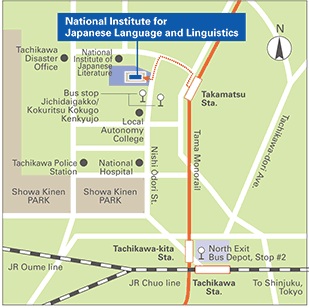JAPANESEENGLISH
National Institute for Japanese Language and Linguistics
International Workshop:
Kakarimusubi from a Comparative Perspective
Outline
"Kakarimusubi" is a term used in traditional Japanese linguistics to refer to a type of focus construction in which a focus particle attaches to a constituent either in situ or in some cases dislocated to a clause-medial position. The focused constituent is the "kakari", while the "musubi" portion refers to the main verb, which takes what is normally a non-matrix (frequently nominalized) inflection. Languages which have been cited in the literature as having such constructions include Old and Middle Japanese, modern Ryukyuan dialects, Sinhala, Tlingit, Yukaghir, and Mingrelian. The goal of the workshop is to examine this construction from a cross-linguistic, as well as cross-theoretical, perspective.
Hosted by
NINJAL Collaborative Research projects: "Typological and Historical/Comparative Research on the Languages of the Japanese Archipelago and its Environs" "A Diachronic Contrastive Study of Japanese Interrogatives"
Organizers
John Whitman, Satoshi Kinsui, Edith Aldridge and Iku Nagasaki
Date / Venue
September 5-6, 2015
National Institute for Japanese Language and Linguistics (NINJAL), Tokyo
Program
September 5 (Sat.)
9:20-9:50 Registration
9:50-10:00 Opening
Session 1
10:00-10:40 John Whitman (NINJAL / Cornell University) Kakarimusubi from a comparative perspective: A crosslinguistic survey of Focus Scope Concord Constructions
10:40-11:20 Hideki Kishimoto (Kobe University) Sinhala Focus Constructions from a Discourse-Syntactic Perspective (abstract)
11:20-12:00 Michinori Shimoji (Kyushu University) Kakarimusubi in the Irabu dialect of Ryukyuan (abstract)
12:00-13:10 Lunch
Session 2
13:10-13:50 Rumiko Shinzato-Simonds (Georgia Institute of Technology) (Old) Okinawan and Old Japanese KM in functional and diachronic perspective: Part I (abstract)
13:50-14:30 Leon Serafim (University of Hawaii ret.) (Old) Okinawan and Old Japanese KM in functional and diachronic perspective: Part II (abstract)
14:30-15:10 Tomohide Kinuhata (Fukuoka University) Kakarimusubi as a device to determine the sentence type (abstract)
15:10-15:30 Break
Session 3
15:30-16:10 Takashi Katsumata (Fukuoka University of Education) On the position of the Old Japanese kakari particle so and the focus expressed by the clause(上代における係助詞ソの出現位置と文の焦点について)(abstract)
16:10-16:50 Edith Aldridge (University of Washington) Two Focus Constructions in Old Japanese Kakari-musubi (abstract)
16:50-17:30 Yoshiyuki Takayama (University of Fukui) Kakarimusubi and Modality(係り結びとモダリティ)(abstract)
17:30-18:00 Discussion
September 6 (Sun.)
9:30-10:00 Registration
Session 4
10:00-10:40 Satoshi Kinsui (Osaka University) On Kakari-musubi and Focus in Interrogative Sentences in Old Japanese(上代日本語の疑問文の係り結びと焦点について)(abstract)
10:40-11:20 Iku Nagasaki (NINJAL) The structural properties of Kolyma Yukaghir's kakarimusubi-like construction (abstract)
11:20-12:00 Honoré Watanabe (Tokyo University of Foreign Studies, ILCAA) Focus Constructions in Sliammon (abstract)
12:00-13:10 Lunch
Session 5
13:10-13:50 Christopher Davis (University of the Ryukyus) Focus, Mood, and Interrogatives in Yaeyaman (abstract)
13:50-14:30 Taiki Yoshimura (Ankara University) Focussing and morpho-syntactic characteristics of Turkish predicates (abstract)
14:30-14:50 Break
Session 6
14:50-15:30 Tomohiro Miyake (Tsurumi University) Kakarimusubi and Wh-Interrogative Sentences in Modern Japanese(現代日本語の不定語疑問文と「係り結び」)(abstract)
15:30-16:10 Charles Quinn (Ohio State University) Why izenkei in koso-focused kakari-musubi?--some considerations (abstract)
16:10-16:50 Discussion
17:50-17:00 Closing
Access
NINJAL
The National Institute for Japanese Language and Linguistics (NINJAL) is located about 1.5km north of Tachikawa Station. You can get from Tachikawa Station to NINJAL on foot, by bus, by monorail, or by taxi.

On foot
On a nice day, the easy 20-minute walk from Tachikawa Station to NINJAL is very pleasant. ( walking directions [ PDF | 888KB ] )
Bus
Buses run frequently between Tachikawa Station and NINJAL, and the ride takes about 5 minutes. There is a bus stop right in front of NINJAL. The bus is probably the best option on a rainy day, but it is not to easy to use if you do not know Japanese, so please follow the instructions provided. The fare is 200 (JPY). ( bus directions [ PDF | 694KB ] )
Monorail
The Tama Monorail stops both on the south side and on the north side of Tachikawa Station. The closest monorail station to NINJAL is Takamatsu, and the ride takes about 2 minutes from Tachikawa-kita (the Monorail station the north side of Tachikawa Station). However, it takes about 7 minutes to walk from Takamatsu station to NINJAL. Please follow the instructions provided. The fare is 100 (JPY). ( monorail directions [ PDF | 499KB ] )
Taxi
There is a taxi stand on the north side of Tachikawa Station near the Starbucks on the ground level. The minimum fare of 730 (JPY) should be enough to get you from there to NINJAL. You can also catch a taxi on the south side of Tachikawa Station, but it will take quite a bit longer and cost more because the driver will have to take a circuitous route to get under the train tracks. A single taxi is big enough to carry 3 people comfortably, and it is usually possible squeeze in 4 people, with one passenger in the front seat. The driver pushes a button to automatically open and close the left rear door (where passengers normally get in and out), and passengers are not supposed to open or close this door themselves. Most drivers do not speak English, but they will understand if you say "Receipt, please." On the other hand, "NINJAL" will mean nothing to a taxi driver, so if you plan to take a taxi, you should print out the taxi directions provided so that you can show them to your driver. ( taxi directions [ PDF | 643KB ] )
Meals during the workshop
Please note that the area around NINJAL offers very few options for food. So we strongly recommend that attendees buy something each morning and bring it to NINJAL. There are a couple of convenience stores close by, and more substantial take-out lunches can be found in and around every major train station, including Tachikawa.